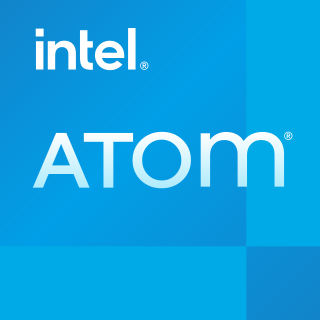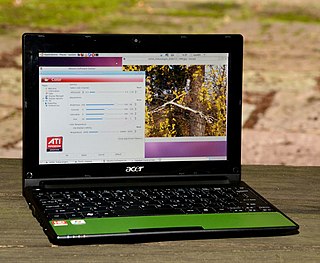Related Research Articles
AMD PowerNow! is AMD's dynamic frequency scaling and power saving technology for laptop processors. The CPU's clock speed and VCore are automatically decreased when the computer is under low load or idle, to save battery power, reduce heat and noise. The lifetime of the CPU is also extended because of reduced electromigration, which varies exponentially with temperature.

The marketing term netbook identified small and inexpensive laptops that were sold from 2007 to around 2013; these were generally low-performance. While the name has fallen out of use, machines matching their description remain an important part of the market for laptops running Microsoft Windows. Similarly, most lower-end Chromebooks run on hardware which would have been described as "Netbooks" when the term was current, and inexpensive tablets when used with an external keyboard are functionally equivalent to netbooks.
The AMD K8 Hammer, also code-named SledgeHammer, is a computer processor microarchitecture designed by AMD as the successor to the AMD K7 Athlon microarchitecture. The K8 was the first implementation of the AMD64 64-bit extension to the x86 instruction set architecture.
Enhanced SpeedStep is a series of dynamic frequency scaling technologies built into some Intel microprocessors that allow the clock speed of the processor to be dynamically changed by software. This allows the processor to meet the instantaneous performance needs of the operation being performed, while minimizing power draw and heat generation. EIST was introduced in several Prescott 6 series in the first quarter of 2005, namely the Pentium 4 660. Intel Speed Shift Technology (SST) was introduced in Intel Skylake Processor.

Socket F is a CPU socket designed by AMD for its Opteron line of CPUs released on August 15, 2006. In 2010 Socket F was replaced by Socket C32 for entry-level servers and Socket G34 for high-end servers.
Samsung Sens is the notebook computer series made by Samsung Electronics. Samsung notebooks are designed similarly to the Acer Aspire, Asus Transformer and Zenbook, Dell Inspiron, HP Pavilion, Stream and Envy series, Lenovo IdeaPad and Toshiba Satellite. While they were available in many countries, the Sens notebook line were for some years now sold in the United States and Canada. However, in mid-October 2008, Samsung announced that it would be re-launching its Sens notebooks on the US market.
The AMD mobile platform is an open platform for laptops from AMD. Though little marketing was done on this platform, it has been competing with the Centrino platform in the segment to gain more marketshare. Each platform has its own specification, catching up the latest technology developments. Since the acquisition of ATI, AMD began to include Mobility Radeon GPUs and AMD chipsets as part of the requirements of the mobile platform; the first of such platforms is the Puma platform.

Socket S1 is the CPU socket type used by AMD for their Turion 64, Athlon 64 Mobile, Phenom II Mobile and later Sempron processors, which debuted with the dual-core Turion 64 X2 CPUs on May 17, 2006.

A multi-core processor is a computer processor on a single integrated circuit with two or more separate processing units, called cores, each of which reads and executes program instructions. The instructions are ordinary CPU instructions but the single processor can run instructions on separate cores at the same time, increasing overall speed for programs that support multithreading or other parallel computing techniques. Manufacturers typically integrate the cores onto a single integrated circuit die or onto multiple dies in a single chip package. The microprocessors currently used in almost all personal computers are multi-core.
AMD Turion is the brand name AMD applies to its x86-64 low-power consumption (mobile) processors codenamed K8L. The Turion 64 and Turion 64 X2/Ultra processors compete with Intel's mobile processors, initially the Pentium M and the Intel Core and Intel Core 2 processors.

Asus Eee is a family of products by AsusTek Computer Inc. The product family began with the release of the Eee PC subnotebook in 2007; since then, the product family has diversified into a number of PC form factors. According to the company, the name Eee derives from "the three Es," an abbreviation of its advertising slogan for the device: "Easy to learn, Easy to work, Easy to play".

Intel Atom is the brand name for a line of IA-32 and x86-64 instruction set ultra-low-voltage microprocessors by Intel Corporation designed to reduce electric consumption and power dissipation in comparison with ordinary processors of the Intel Core series. Atom is mainly used in netbooks, nettops, embedded applications ranging from health care to advanced robotics, and mobile Internet devices (MIDs). The line was originally designed in 45 nm complementary metal–oxide–semiconductor (CMOS) technology and subsequent models, codenamed Cedar, used a 32 nm process.

Moblin, short for 'mobile Linux', is a discontinued open source operating system and application stack for Mobile Internet Devices (MIDs), netbooks, nettops and embedded devices.

Acer Aspire One is a line of netbooks first released in July 2008 by Acer Inc.

Snapdragon is a suite of system on a chip (SoC) semiconductor products for mobile devices designed and marketed by Qualcomm Technologies Inc. The Snapdragon's central processing unit (CPU) uses the ARM architecture. A single SoC may include multiple CPU cores, an Adreno graphics processing unit (GPU), a Snapdragon wireless modem, a Hexagon digital signal processor (DSP), a Qualcomm Spectra image signal processor (ISP) and other software and hardware to support a smartphone's global positioning system (GPS), camera, video, audio, gesture recognition and AI acceleration. As such, Qualcomm often refers to the Snapdragon as a "mobile platform". Snapdragon semiconductors are embedded in devices of various systems, including Android, Windows Phone and netbooks. They are also used in cars, wearable devices and other devices. In addition to the processors, the Snapdragon line includes modems, Wi-Fi chips and mobile charging products.

HP TouchSmart is a series of tablet PC laptops and touchscreen all-in-one desktop computers designed by HP. It features various Intel or AMD processors and runs Windows Vista or Windows 7 as standard.

HP Mini is a former line of small computers categorized as netbooks manufactured by Hewlett-Packard. They either contained a custom version of Ubuntu Linux, Microsoft Windows XP Home Edition or Windows 7 Starter operating system. Like most netbooks, they were not built with CD/DVD drives. However, HP did sell portable DVD-ROMs with HP's LightScribe disc imaging software. These netbooks are best used for written documents, small programs and web browsing. They can run standard software, but given their low price, they tend to have low end specifications, causing poor performance. They were announced from mid-2007, and marketed from 2008 through 2012.

The Intel-based MacBook Air is a discontinued line of notebook computers developed and manufactured by Apple Inc. from 2008 to 2020. The Air was originally positioned above the previous MacBook line as a premium ultraportable. Since then, the original MacBook's discontinuation in 2011, and lowered prices on subsequent iterations, made the Air Apple's entry-level notebook.
References
- ↑ "Everun Note based on dual-core processor AMD Turion". dagadgets.com. 2008. Retrieved 2008-08-16.
- ↑ "Everun Note marketing info gives performance figures". umpcportal.com. 2008. Retrieved 2008-08-13.